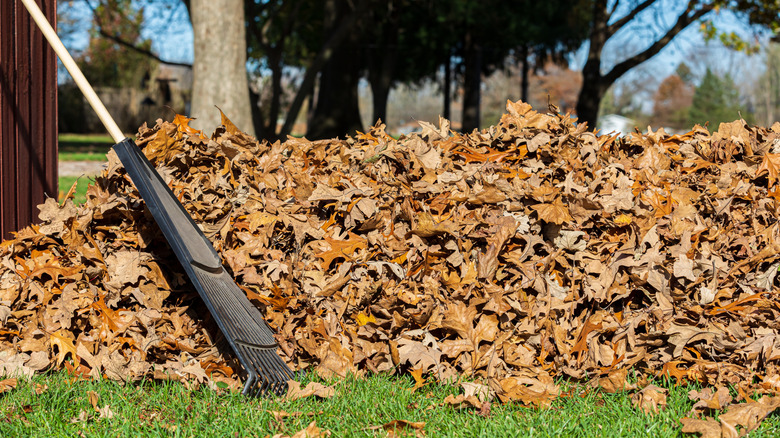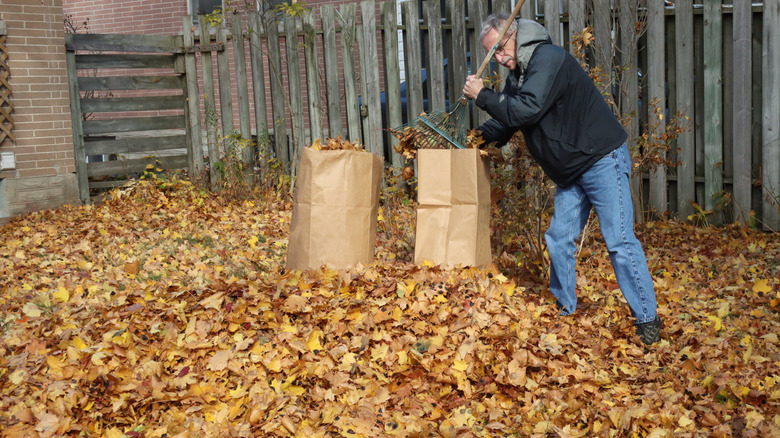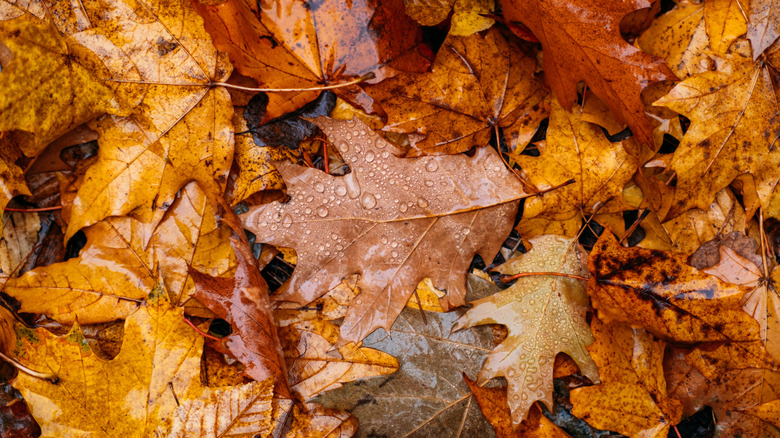Why You Should Never Let The Raked Leaves In Your Lawn Pile Up
For many homeowners, there is something tempting about leaving fall leaves scattered across their lawn. On an aesthetic level, few things scream autumn as obviously as a blanket of beautiful red and gold leaves crunching underfoot as you walk across your yard. But raking leaves can also be very stressful on the body, so it's a chore that many people would prefer to avoid. Unfortunately, allowing leaves to pile up on your lawn can be very detrimental to your grass, smothering it and causing fungus growth that can lead to a patchy, uneven lawn come spring.
When it comes to leaf removal, though, raking shouldn't necessarily be your go-to move. The debate on raking versus mowing the leaves in your yard may seem strange since we've already discussed that leaves left on your lawn can cause serious damage. However, mowing the leaves mulches them, so they're chopped into tiny pieces. Instead of smothering your grass, these small bits of organic material return vital nutrients to the soil, which can actually benefit your lawn by working as a natural fertilizer and prohibiting weed growth. However, if you're on team raking, make sure to bag your piled leaves.
Leaves can block sunlight
One of the main reasons why the 'leave the leaves' movement is a bad idea for most lawns is that a thick layer of leaves can smother your grass. If the pile of leaves is deep enough that you can't see the grass, sunlight can't reach the lawn, either. Sunlight is necessary for photosynthesis, the process by which grass and other plants produce energy. This energy is crucial for encouraging healthy grass growth, as well as strong roots and blades.
Because your lawn goes dormant when the temperatures drop in winter, it's essential for the grass to build up energy reserves. Otherwise, it won't have the necessary food to feed itself in winter. Grass with strong roots and blades is also more likely to survive the extreme weather conditions it may encounter in winter. If your lawn can't receive the sunlight it needs to strengthen itself and store energy for the cold weather, it will likely die. When spring returns, the grass is often a patchy mess.
Leaves can cause fungus and mold growth
In addition to blocking sunlight, leaf piles are also prone to trapping moisture and hindering evaporation. A layer of leaves can reduce air circulation, too. If the leaves become damp and are left to sit, they can take a very long time to dry. As a result, your lawn can become a prime breeding ground for various fungi, including mold.
In particular, trapped moisture is likely to cause crown and root rot, a fungal disease that leads to thinning and slow growth, as well as snow mold. Another fungal disease, snow mold leaves crusty white or tan patches in your grass after winter snow melts. Mold isn't just a danger to your grass, though. Fungi and mold spores can also pose a risk to you and your family, including pets, as they can cause various illnesses. In fact, lawn fungi are linked to lung infections across the United States. Young children, seniors, and individuals with compromised immune systems may experience fever, fatigue, and cough if they inhale the fungal spores. Understanding when your lawn is most susceptible to fungus and removing leaves quickly is the best way to keep everyone safe.


